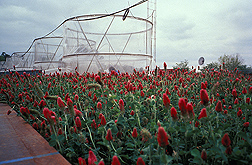What Goes Up?
Measuring Air and Soil Carbon Exchange
From Conservation Cropping Systems
|
|
It freezes food, douses flames, and makes soft drinks fizzy.
There’s no denying that carbon dioxide (CO2) is extremely versatile—as are its environmental effects. CO2 promotes plant growth, but it also contributes to the greenhouse effect. If CO2 concentrations double within the next century, as some scientists predict, how should agriculture respond?
ARS National Soil Dynamics Laboratory scientists in Auburn, Alabama, are examining how different management practices—such as conventional and conservation tillage—affect carbon storage. Their research will reveal some potential benefits and other consequences of increased CO2 concentrations and how we can influence them.
In its eighth year, this is the world’s oldest study comparing the effects of elevated and ambient levels of CO2 on different cropping systems, says plant pathologist G. Brett Runion, who conducted the research with plant physiologist Stephen A. Prior and research leader H. Allen Torbert.
A series of cylindrical open-top field chambers, 8 feet tall and 10 feet wide, exposes crops to varying levels of atmospheric CO2; soil and plant responses within these chambers are measured periodically.
“We want to understand how agricultural systems can best be managed to increase the amount of carbon stored in plant residues and soil,” Runion says.
Increased carbon storage has multiple benefits, such as reduced soil erosion and compaction, increased water-holding capacity for plants, and slower rise in atmospheric CO2 concentration. Policymakers, action agencies, and businesses interested in trading carbon credits could use data from the study to make better decisions.
Runion is also using the Automated Carbon Efflux System (ACES) to track CO2 as it travels from soil to atmosphere. The system was developed by John Butnor and Kurt Johnsen of the USDA Forest Service.
ACES is an open-flow system, so the pressure within its chambers does not build up and affect the CO2 levels. Unlike most measurement systems, which only allow for periodic assessments, ACES provides continual measurement of CO2 over the entire growing season.
“Our research will help determine how much carbon can be stored in the soil under various management practices and which practices return more carbon to the atmosphere,” says Prior.
Currently, the group is using ACES to monitor CO2 coming out of soil for a sorghum-soybean rotation exposed to elevated or ambient levels of atmospheric CO2 and managed with either conventional or conservation practices.
Preliminary results suggest that conservation management practices may enhance the benefits of elevated CO2 concentrations, such as larger plants and higher yields. Results also show that elevated CO2 increases soil carbon, particularly when crops are grown with conservation management practices, despite greater amounts of CO2 going back to the atmosphere from the soil.
Future plans include using the equipment to monitor other trace gases, such as methane and nitrous oxide, which are also suspected causes of global warming.—By Laura McGinnis, Agricultural Research Service Information Staff.
This research is part of Global Change, an ARS National Program (#204) described on the World Wide Web at www.nps.ars.usda.gov.
G. Brett Runion, Stephen A. Prior, and H. Allen Torbert are at the USDA-ARS National Soil Dynamics Laboratory, 411 S. Donahue Dr., Auburn, AL 36832; phone (334) 844-4741, fax (334) 887-8597.
"Measuring Air and Soil Carbon Exchange From Conservation Cropping Systems" was published in the August 2006 issue of Agricultural Research magazine.







